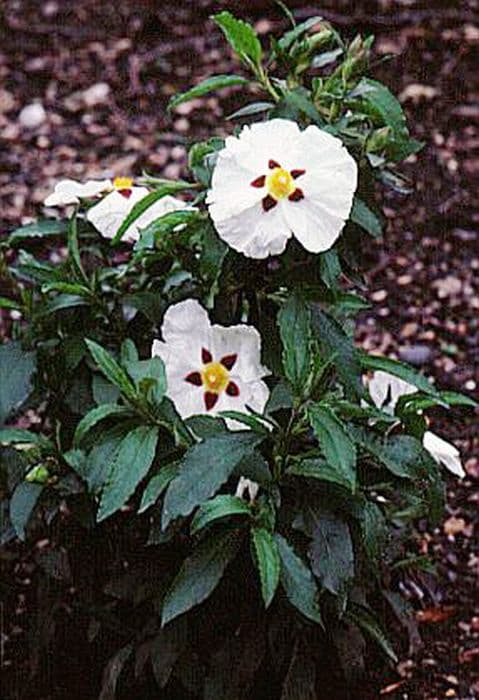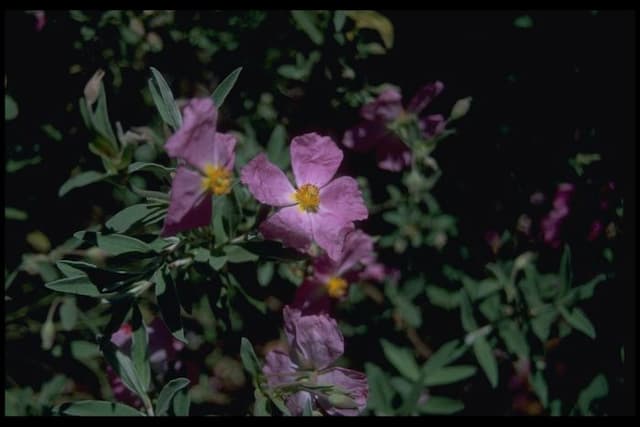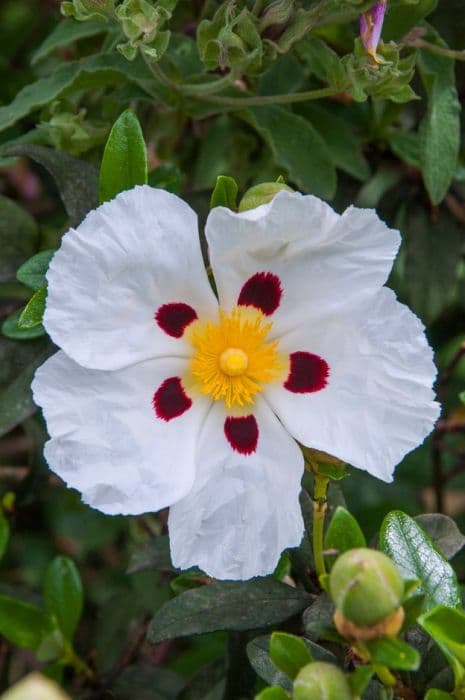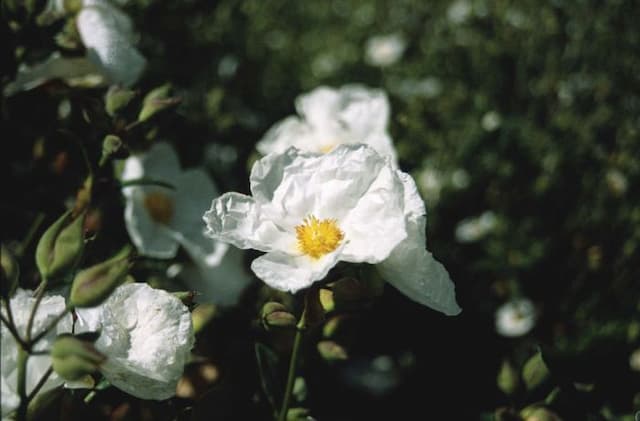Rock Rose × Halimiocistus wintonensis

ABOUT
× Halimiocistus wintonensis, commonly known as the rock rose, is a visually striking plant that boasts a blend of ornamental features. This plant typically displays a bushy growth habit with a generous spread of evergreen foliage. Its leaves are small, glossy, and dark green, providing a lush backdrop throughout the year. The rock rose is most celebrated for its flowers, which are a prominent feature during its blooming season. Each blossom is composed of five petals that form a saucer shape, radiating from the center of the flower. The petals are usually crisp white, often adorned with a vibrant, contrasting maroon or reddish blotch at the base, drawing the eye and adding a splash of color to the display. These flowers can create a splendid show and are known for their resilience, capable of withstanding a range of conditions. In between the flowering periods, the plant's evergreen nature ensures that it maintains visual interest in the garden, its dense foliage providing a mid to dark green color that can serve as a backdrop for other plants or as a standalone feature. The overall appearance of the rock rose exudes a sense of hardiness and adaptability, making it a popular choice for gardeners looking to bring long-lasting and impactful color to their landscapes, while also enjoying the low-maintenance nature afforded by such resilient shrubs. Its appearance harmonizes well with various garden styles, from rock gardens and coastal settings to traditional flower borders and Mediterranean-themed gardens.
About this plant
 Names
NamesFamily
Cistaceae
Synonyms
Rock Rose, Halimiocistus Wintonensis
Common names
× Halimiocistus wintonensis
 Toxicity
ToxicityTo humans
There is limited specific information available about the toxicity of the Rock Rose to humans. However, most species in the Cistus genus, which includes the Rock Rose, are not known to be toxic to humans. In the absence of specific data about × Halimiocistus wintonensis, it would be prudent to avoid ingesting any part of the plant. If a plant is poisonous, symptoms can vary widely but may include gastrointestinal distress such as vomiting, diarrhea, nausea, and abdominal pain; or more systemic effects such as dizziness, headache, and in severe cases, respiratory or cardiac issues. If you suspect poisoning, it is important to seek medical attention promptly.
To pets
Information regarding the toxicity of Rock Rose to pets is also not extensively documented. In general, plants from the Cistus genus are not known to be particularly toxic to animals. Nevertheless, without specific information on × Halimiocistus wintonensis, it is wise to prevent pets from ingesting parts of the plant. Ingesting plants that are poisonous to pets could cause symptoms ranging from mild gastrointestinal upset with vomiting and diarrhea to more serious conditions involving the nervous or cardiovascular systems, depending on the plant's specific toxins. If you suspect your pet has ingested a toxic plant, you should contact a veterinarian as soon as possible.
 Characteristics
CharacteristicsLife cycle
Perennials
Foliage type
Evergreen
Color of leaves
Green
Flower color
Yellow
Height
2 feet (0.6 meters)
Spread
5 feet (1.5 meters)
Plant type
Shrub
Hardiness zones
8
Native area
Mediterranean
Benefits
 General Benefits
General Benefits- Ornamental appeal: × Halimiocistus wintonensis, commonly known as Rock Rose, adds aesthetic value to gardens with its bright, showy flowers.
- Drought tolerance: Rock Rose is well-suited to dry conditions, requiring minimal watering once established, making it a good choice for xeriscaping and water-wise gardens.
- Low maintenance: This plant requires minimal upkeep, making it suitable for gardeners with limited time or those who prefer a low-maintenance garden.
- Wildlife attraction: The blossoms of the Rock Rose attract pollinators like bees and butterflies, supporting biodiversity in the garden.
- Growth habit: Rock Rose grows as a compact shrub, making it suitable for borders, rockeries, and small gardens where space is at a premium.
- Soil adaptability: It can thrive in a range of soil types, including poor and sandy soils, as long as they are well-draining.
- Fast-growing: Rock Rose plants grow relatively quickly, providing swift coverage and achieving their full size within a few growing seasons.
- Evergreen foliage: The plant retains its leaves throughout the year, ensuring persistent color and structure in the garden.
 Medical Properties
Medical PropertiesThis plant is not used for medical purposes.
 Air-purifying Qualities
Air-purifying QualitiesThis plant is not specifically known for air purifying qualities.
 Other Uses
Other Uses- Halimiocistus wintonensis, commonly known as rock rose, can be used for erosion control due to its low-growing, spreading habit, helping to stabilize soil on slopes and embankments.
- Rock rose plants are suitable for xeriscaping, a landscaping method that reduces the need for irrigation, due to their drought resistance.
- The dense, mat-forming nature of rock rose makes it an effective ground cover for suppressing weeds in the garden.
- With its evergreen foliage and prolific flowering, rock rose can be used to create inviting habitat for pollinators such as bees and butterflies.
- Rock roses can be used in coastal gardens, as they are tolerant of salty winds and can thrive in sandy soils.
- In garden design, rock rose is often used to provide a contrast with its silver-green leaves against darker foliage or brightly colored flowers.
- The plant can be used in container gardens where its drought tolerance makes it less maintenance for gardeners.
- Rock rose can be employed in rockeries or alpine gardens to complement other drought-tolerant species and create a varied texture landscape.
- The plant is sometimes used in themed gardens, like Mediterranean or dry-climate gardens, due to its origin and appearance.
- The attractive flowers of rock rose can be used as a natural decoration for cakes and pastries when crystallized or used fresh.
Interesting Facts
 Feng Shui
Feng ShuiThe Rock Rose is not used in Feng Shui practice.
 Zodiac Sign Compitability
Zodiac Sign CompitabilityThe Rock Rose is not used in astrology practice.
 Plant Symbolism
Plant Symbolism- Resilience: As a hardy shrub that can thrive in poor soil conditions, Halimiocistus wintonensis symbolizes the ability to persist and endure challenging situations.
- Adaptability: Given its tolerance for various environments, this plant represents flexibility and the willingness to adapt to new circumstances.
- Beauty in Simplicity: The modest yet eye-catching flowers of Halimiocistus wintonensis suggest that beauty can be found in simple, unassuming forms.
- Protection: As a dense shrub, it can act as a protective barrier in gardens, symbolizing safety and sanctuary.
 Water
WaterThe Rock Rose (× Halimiocistus wintonensis) prefers a moderate watering schedule, ensuring the soil is partially dry before the next watering. During the active growing season in spring and summer, water the plant once every week with about 1 gallon of water, depending on the size and the pot's drainage. In fall and winter, reduce watering to every two to three weeks, as the plant enters a dormant period. Overwatering can lead to root rot, so it is crucial to check that the pot allows for proper drainage.
 Light
LightRock Rose thrives in full sunlight and should be placed in a spot where it receives at least 6 to 8 hours of direct sunlight daily. Avoid shaded areas, as insufficient light can hinder flowering and growth. A south-facing garden spot or window is ideal to provide the necessary sunlight for this plant.
 Temperature
TemperatureRock Rose enjoys temperate climates and performs best in temperatures between 50°F and 75°F. The plant can tolerate occasional dips below freezing, but prolonged exposure to temperatures below 20°F may damage or kill the plant. Ideal growth conditions are achieved when nighttime temperatures are cooler than daytime temperatures.
 Pruning
PruningPruning Rock Rose is important to maintain its shape and encourage denser growth. Prune in late winter or early spring before new growth begins, removing any dead or damaged branches and shaping the plant as desired. Avoid heavy pruning; instead, focus on light trimming to keep the plant healthy and well-groomed.
 Cleaning
CleaningNot needed
 Soil
SoilThe Rock Rose (× Halimiocistus wintonensis) thrives in a well-draining, sandy loam with added gravel for improved drainage. The ideal soil mix is one part sand or grit to two parts standard potting compost. The plant prefers a slightly acidic to neutral pH, ranging from 6.0 to 7.5.
 Repotting
RepottingThe Rock Rose should be repotted every two to three years or when it outgrows its current pot. It is best to repot in the spring just before the growing season begins.
 Humidity & Misting
Humidity & MistingThe Rock Rose prefers average to low humidity levels and can tolerate dry atmospheric conditions. It is well-suited for typical indoor humidity levels and does not require additional humidity.
 Suitable locations
Suitable locationsIndoor
Place Rock Rose in bright, indirect light indoors.
Outdoor
Plant in full sun, in well-drained soil outdoors.
Hardiness zone
8-11 USDA
 Life cycle
Life cycle× Halimiocistus wintonensis, also known as rock rose, begins its life as a seed that germinates in well-drained soil during the warm season. Once the seedling emerges, it focuses on developing a robust root system and foliage through the juvenile stage. As it matures, the plant enters a vegetative stage, forming a woody base and branching structure supportive of its flowering capacity. The adult rock rose blooms in late spring to summer, producing showy, saucer-shaped flowers that attract pollinators. Following pollination, the plant sets seed, which is then dispersed by various means, including wind and possibly wildlife. In, its perennial nature allows the rock rose to repeat the flowering and seed-setting cycle for several years, with individual plants living a decade or more under optimal conditions.
 Propogation
PropogationPropogation time
Spring-Early Summer
The Rock Rose (× Halimiocistus wintonensis) is most commonly propagated through semi-ripe cuttings taken in late summer. To propagate using this method, a gardener should select a healthy stem that is not flowering and cut a piece approximately 4 to 6 inches (10 to 15 centimeters) long just below a leaf node. The lower leaves are removed, and the cut end can be dipped in rooting hormone to encourage root growth. The cutting is then placed in a pot filled with a mixture of peat and perlite or a similar free-draining propagation medium. The pot should be kept at a consistent moisture level but not waterlogged, and placed in a warm spot with indirect light. Roots typically develop within a few weeks, after which the new Rock Rose plant can eventually be potted up or transplanted outdoors once it has grown sufficiently and the risk of frost has passed.









